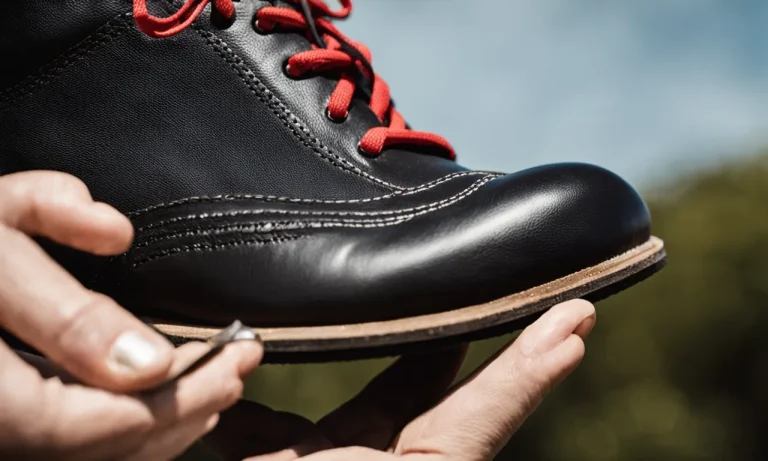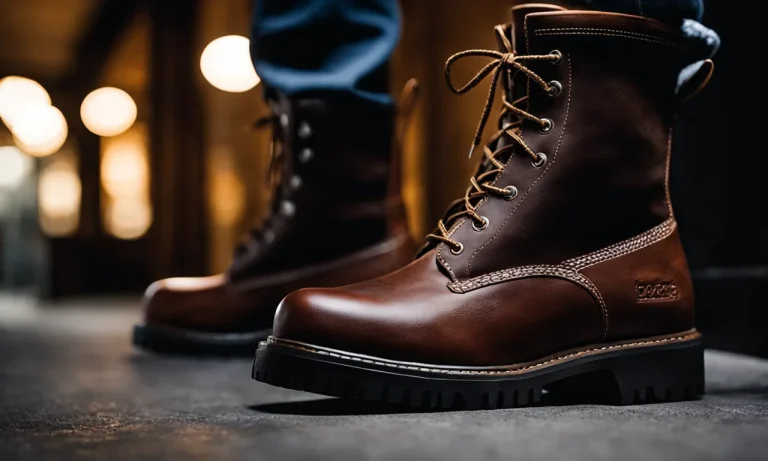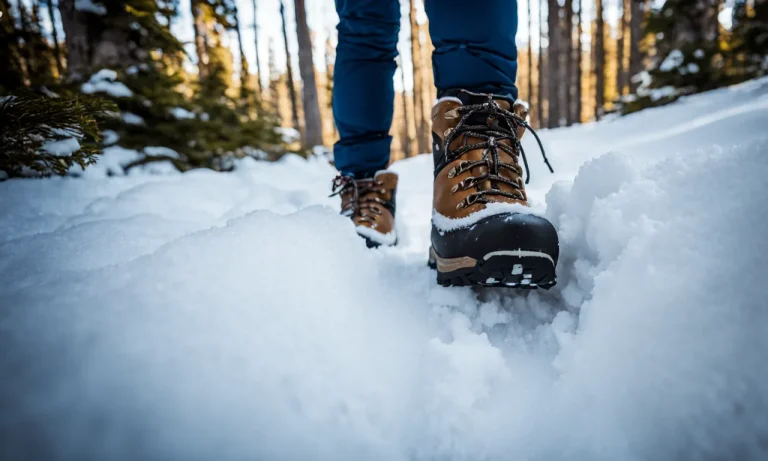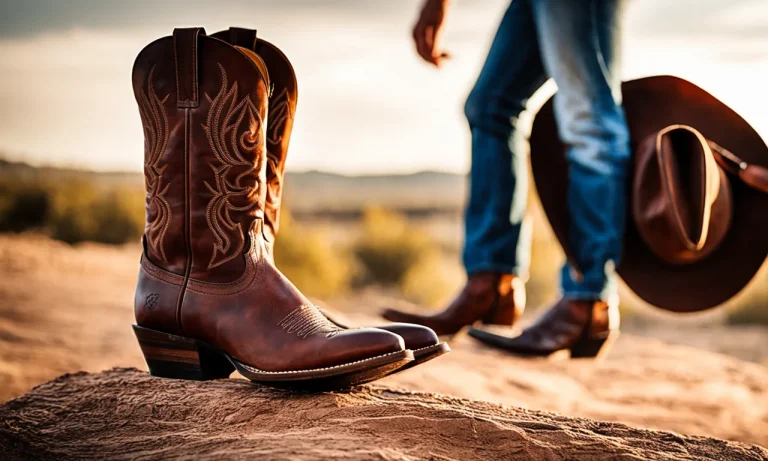Are you looking for the perfect pair of waterproof boots to keep your feet warm and dry this winter? Finding boots that can stand up to cold temperatures and winter precipitation while still being comfortable and stylish can be a challenge.
If you’re short on time, here’s a quick answer to your question: Look for insulated, waterproof boots with 200g insulation or more, a waterproof membrane like Gore-Tex, full-grain leather uppers, and a high traction rubber outsole for optimal winter performance and comfort.
In this comprehensive guide, we’ll discuss the most important features to look for when shopping for waterproof cold weather boots, provide tips for choosing the right pair, review the top-rated models on the market, and answer frequently asked questions about staying warm and dry all winter long.
What to Look for in Waterproof Cold Weather Boots
When it comes to choosing the best waterproof cold weather boots, there are several factors to consider. These boots need to keep your feet warm and dry in the harshest of conditions, so it’s essential to choose the right features that will meet your needs. Here are some key factors to look for:
Insulation Type and Rating
The insulation of your cold weather boots is crucial for keeping your feet warm in low temperatures. Look for boots with high-quality insulation materials such as Thinsulate or PrimaLoft. These materials provide excellent warmth without adding too much bulk to the boots.
Additionally, pay attention to the insulation rating, which indicates the temperature range the boots are designed for. A higher insulation rating means the boots will provide better warmth in colder conditions.
Waterproof Membrane
A reliable waterproof membrane is essential for keeping your feet dry in wet and snowy conditions. Look for boots that feature a waterproof membrane, such as Gore-Tex or eVent, which effectively repel water while allowing moisture to escape.
This ensures that your feet stay dry and comfortable throughout your outdoor adventures.
Outsole Material and Tread
The outsole material and tread pattern of your boots play a vital role in providing traction and stability on slippery surfaces. Look for boots with a durable rubber outsole that offers excellent grip.
A deep and aggressive tread pattern will provide better traction on snow and ice, reducing the risk of slips and falls.
Uppers
The material used for the uppers of your cold weather boots can impact their durability and weather resistance. Look for boots with uppers made of waterproof and durable materials like full-grain leather or synthetic materials treated with a waterproof coating.
These materials will keep your feet protected from rain, snow, and cold wind.
Fit and Sizing
Getting the right fit and sizing is crucial for optimal comfort and performance. Make sure to try on the boots and walk around in them to ensure a proper fit. Consider wearing thick socks to account for extra insulation.
It’s also a good idea to read customer reviews and check the sizing charts provided by the manufacturer to find the right size for your feet.
By considering these factors, you can confidently choose the best waterproof cold weather boots that will keep your feet warm, dry, and comfortable in any winter conditions.
The Best Waterproof Cold Weather Boots for Men
When it comes to braving the elements during the winter months, having a reliable pair of waterproof cold weather boots is essential. These boots not only keep your feet warm and dry but also provide the necessary traction to navigate slippery surfaces. Here are some of the best options for men:
Baffin Impact Insulated Boot
The Baffin Impact Insulated Boot is designed to withstand extreme cold temperatures and harsh winter conditions. With a waterproof construction and a temperature rating of up to -148°F (-100°C), these boots are perfect for those who live in exceptionally cold climates.
The durable rubber sole provides excellent traction, while the removable multi-layer inner boot system ensures maximum warmth and comfort.
Sorel Caribou Boot
The Sorel Caribou Boot is a classic winter boot that has stood the test of time. These boots feature a waterproof full-grain leather upper and a removable felt liner that provides insulation in temperatures as low as -40°F (-40°C).
The handcrafted vulcanized rubber shell and the non-slip rubber outsole offer superior traction on icy surfaces, making them ideal for outdoor activities in cold weather.
Kamik NationPlus Boot
The Kamik NationPlus Boot is a reliable and affordable option for those looking for waterproof cold weather boots. These boots feature a waterproof suede and nylon upper, as well as a moisture-wicking lining to keep your feet dry.
With a temperature rating of -40°F (-40°C) and a rugged rubber outsole for traction, these boots are suitable for various winter activities.
Columbia Bugaboot Plus IV
The Columbia Bugaboot Plus IV is a versatile and durable boot that can handle extreme weather conditions. These boots are equipped with a waterproof leather and textile upper, as well as Columbia’s Omni-Heat reflective lining that retains body heat.
The Techlite lightweight midsole provides superior cushioning and energy return, while the Omni-Grip non-marking traction rubber outsole ensures stability on slippery surfaces.
When choosing the best waterproof cold weather boots for men, it’s important to consider factors such as insulation, waterproofing, traction, and durability. These four options offer a combination of these features, making them great choices for keeping your feet warm and dry during the winter months.
The Best Waterproof Cold Weather Boots for Women
Baffin Women’s Iceland Boot
The Baffin Women’s Iceland Boot is a top choice for women looking for a durable and waterproof option in cold weather. These boots are designed with a waterproof leather upper and a removable multi-layer inner boot system, providing excellent insulation and protection against the elements.
With a temperature rating of -40°C/-40°F, these boots will keep your feet warm and dry in even the harshest conditions. The rubber outsole offers great traction on slippery surfaces, making them ideal for winter activities like hiking or walking in the snow.
Sorel Joan of Arctic Boot
The Sorel Joan of Arctic Boot is a stylish and functional option for women who want to stay warm and dry during the winter months. These boots feature a waterproof suede upper and a faux fur cuff, adding a touch of flair to your cold-weather wardrobe.
The removable felt inner boot provides excellent insulation, while the vulcanized rubber outsole offers superior traction on icy surfaces. These boots are also rated to -32°C/-25°F, ensuring your feet stay cozy no matter how low the temperatures drop.
Kamik Heidi Boot
The Kamik Heidi Boot is a practical and affordable choice for women seeking waterproof cold weather boots. These boots are made from lightweight and flexible synthetic rubber, providing 100% waterproof protection.
The removable footbed is cushioned for added comfort, and the outsole is designed to provide traction on slippery surfaces. With a mid-calf height, these boots offer ample coverage and protection against snow and slush.
Whether you’re shoveling snow or running errands in the winter, the Kamik Heidi Boot is a reliable option.
Columbia Minx Mid III Boot
The Columbia Minx Mid III Boot combines style and functionality for women who want to look great while staying warm and dry. These boots feature a waterproof woven textile upper with faux fur trim, adding a fashionable touch to your winter ensemble.
The 200g insulation and Omni-Heat reflective lining provide excellent warmth, while the non-marking rubber outsole offers traction on various surfaces. These boots also have a convenient lace-up closure system, allowing you to adjust the fit to your liking.
With the Columbia Minx Mid III Boot, you can stay comfortable and stylish in cold weather.
Tips for Choosing the Right Pair of Cold Weather Boots
When it comes to braving the cold and wet winter weather, having a reliable pair of waterproof boots is essential. Whether you’re planning a snowy hike, shoveling the driveway, or simply running errands in chilly temperatures, here are some tips to help you choose the right pair of cold weather boots:
Consider Your Climate and Winter Activities
Before purchasing cold weather boots, it’s important to consider the climate and the activities you’ll be doing. If you live in an area with heavy snowfall and frigid temperatures, you’ll want to look for boots that provide insulation and are rated for extreme cold.
On the other hand, if you’ll be mainly dealing with wet conditions, focus on finding boots that have excellent waterproofing capabilities.
For those planning outdoor activities like hiking or snowshoeing, look for boots with good traction to prevent slips and falls. If you’ll be primarily using your boots for everyday wear, opt for a more versatile style that can be dressed up or down.
Look for Temperature Ratings
Cold weather boots often come with temperature ratings, indicating the lowest temperatures at which they can keep your feet warm. These ratings can vary, so it’s important to choose boots that are appropriate for the temperatures you’ll be facing.
Some boots are designed for extreme cold, with temperature ratings as low as -40 degrees Fahrenheit (-40 degrees Celsius). Others may be suitable for milder winter conditions, with ratings around 20 degrees Fahrenheit (-7 degrees Celsius).
Keep in mind that personal comfort levels can vary, so it’s always a good idea to go for a boot with a slightly lower temperature rating than you anticipate needing.
Try Them On with Warm Socks
When trying on cold weather boots, wear the type of socks you would typically wear in cold weather conditions. This will give you a better idea of how the boots will fit and feel when you’re out in the cold.
Make sure there is enough room for your toes to wiggle and that the boots provide adequate support and cushioning.
Remember that your feet may swell slightly in cold weather, so it’s important to choose boots that aren’t too tight. If you plan on wearing thicker socks for added warmth, consider going up a half size to accommodate them.
Break Them In Before Wearing All Day
Cold weather boots, like any new pair of shoes, may require some breaking in before they become comfortable for all-day wear. To avoid discomfort and blisters, wear your new boots around the house or on shorter outings to allow them to mold to your feet.
If you have specific winter activities planned, such as a long hike or skiing trip, make sure to break in your boots well in advance. This will give you the opportunity to address any fit or comfort issues before you’re out in the cold for an extended period of time.
Use Proper Care and Maintenance
To ensure that your cold weather boots last for many winters to come, it’s important to properly care for and maintain them. After each use, wipe off any dirt or salt and allow them to air dry. If your boots are made of leather or suede, apply a waterproofing spray to protect them from moisture.
Regularly inspect your boots for any signs of wear or damage, such as worn-out soles or loose stitching. Address any issues promptly to prevent further damage. Proper storage is also important – keep your boots in a cool, dry place away from direct sunlight.
By following these tips, you’ll be well-equipped to choose the right pair of cold weather boots that will keep your feet warm, dry, and comfortable throughout the winter season.
Frequently Asked Questions
How warm do my boots need to be for winter?
When it comes to choosing the right winter boots, the level of warmth you need depends on the climate and the activities you’ll be doing. In extremely cold temperatures, boots with a temperature rating of -40°C or lower are recommended.
For milder winter conditions, a temperature rating of -20°C to -30°C should suffice. It’s important to consider factors such as insulation, lining material, and the type of activities you’ll be engaged in to ensure your feet stay warm and comfortable.
What insulation rating should I look for?
The insulation rating of your winter boots is crucial in keeping your feet warm. Look for boots with insulation materials such as Thinsulate or PrimaLoft, which provide excellent warmth without adding too much bulk. Insulation ratings are often measured in grams per square meter (g/m²).
A higher insulation rating indicates better warmth retention. For extreme cold weather conditions, look for boots with insulation ratings of around 400g/m² or higher. For milder temperatures, boots with ratings between 200g/m² and 400g/m² should be sufficient.
Is Gore-Tex worth it in winter boots?
Gore-Tex is a popular waterproof and breathable membrane used in many winter boots. It is worth considering if you anticipate being exposed to wet or snowy conditions. Gore-Tex technology allows moisture to escape while preventing water from entering the boot, keeping your feet dry and comfortable.
It is a reliable and durable material that can enhance the overall performance of your winter boots. However, it is important to note that Gore-Tex boots may come at a higher price point compared to non-Gore-Tex options.
How can I waterproof my boots at home?
If you already have a pair of boots that are not waterproof, there are several methods you can try at home to make them more water-resistant. One option is to use a waterproofing spray or wax specifically designed for footwear. Apply the product evenly and allow it to dry thoroughly.
Another method is to use a beeswax or silicone-based waterproofing compound and apply it to the seams and stitching of the boots. This helps create a barrier against water penetration. Remember to follow the manufacturer’s instructions and test the product on a small, inconspicuous area before applying it to the entire boot.
How can I make my boots more slip resistant?
To improve the slip resistance of your boots, there are a few steps you can take. First, consider adding traction devices such as ice cleats or crampons to the soles of your boots. These can provide extra grip on icy or slippery surfaces.
Second, choose boots with a lug sole pattern, which features deep, aggressive treads that offer better traction. Finally, make sure to keep the soles of your boots clean and free from debris, as dirt and mud can reduce traction.
Regularly inspect the condition of your boots and replace worn-out soles to ensure optimal slip resistance.
Conclusion
Staying warm, dry, and steady on your feet all winter requires having the right footwear. Waterproof cold weather boots with ample insulation, grippy outsoles, and weatherproof membranes like Gore-Tex will keep you comfortable in even the harshest conditions.
Be sure to consider insulation ratings, fit, climate, and intended use when selecting your perfect pair. With the right boots, you’ll be prepared to take on all of winter’s weather and activities with ease.






